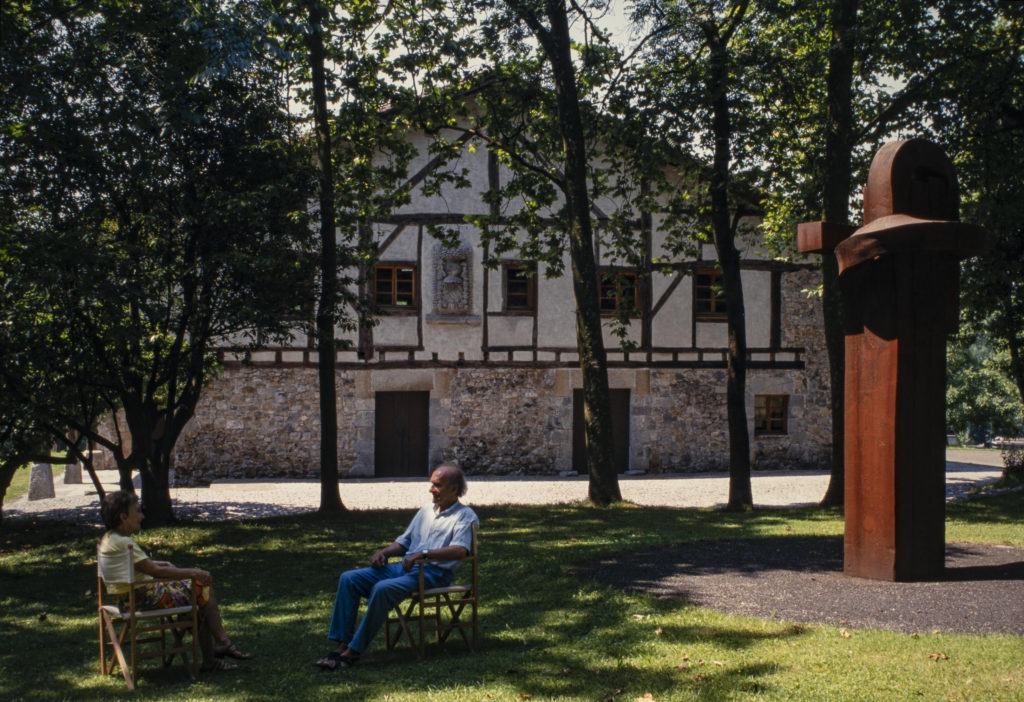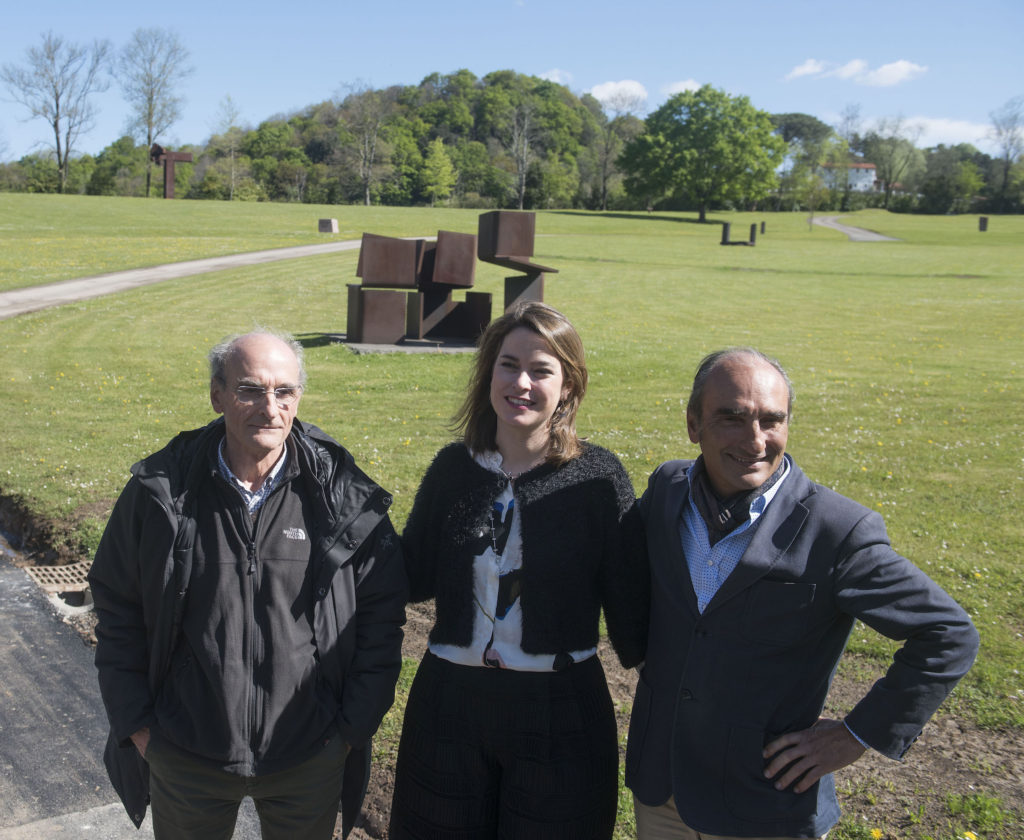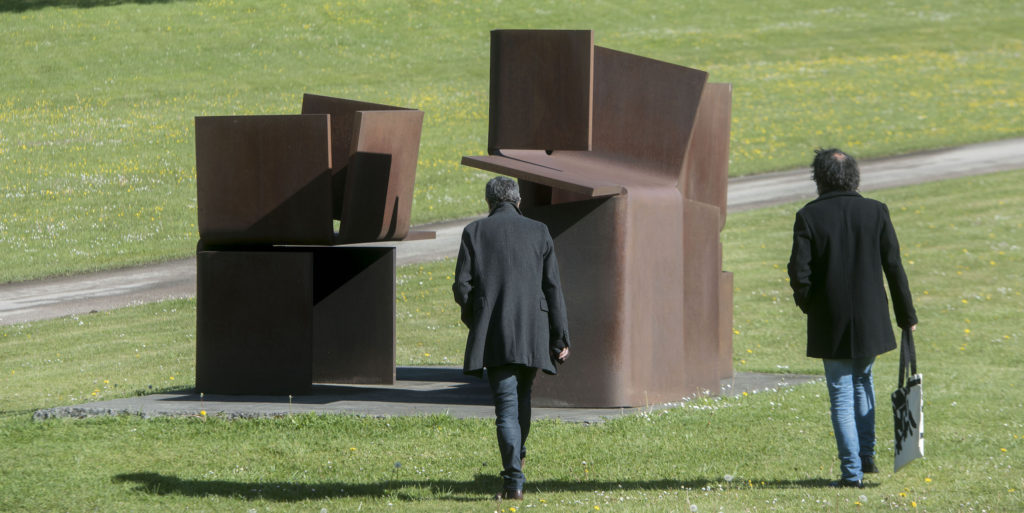Chillida Leku, closed for eight years, is once again shining bright in Hernani, beside the city of Donostia. Opened for the first time on September 16th, 2000 at the 16th century Basque farmhouse Zabalaga, which Eduardo Chillida (Born in Donostia in 1924 – Died in Donostia in 2002) and his spouse, Pilar Belzunce, purchased in the 1980’s. The building and surrounding land, an area of 11 hectares, were developed by the couple, in collaboration with the Basque architect Joaquín Montero. The sculptor devised this place (leku, in Basque) for his pieces, “a utopia” where they could “repose” while people walk amid them as if they were “strolling through a forest.”
The reopening has been possible thanks solely to the efforts of the Swiss gallery Hauser & Wirth, one of the most prominent worldwide. It was in December 2017, when it announced the international representation of the works of the Basque artist and the reopening which finally took place on April 17th. The Swiss gallery offered a solution to an issue that the Chillida family had been dealing with since even before January 1, 2011, the date on which this utopia closed its doors.

During the eight years in which the Museum has been closed (visits have been possible by appointment and also by rental accumulating 50,000 visitors during this period) there were several attempts to promote its reopening, through governmental support; but none of the negotiations were successful. In the first decade, more than 800,000 people passed through the center, however, an accumulated deficit of 2 million euros (€500,000 in 2010 alone) which accelerated during the years of the economic crisis, forced the artist’s family to seek greater governmental involvement.
In 2009, for example, the Chillida family proposed the transfer of 112 million euros by the Basque Government in exchange for the lands and works when, Sotheby’s auction house valued the legacy of the artist at 176 million a year earlier. However, the change in the Basque Presidency in the wake of that year’s elections (Socialist Patxi López replaced the nationalist Juan José Ibarretxe) brought about a renegotiation with the government, which offered a maximum of 80 million euros for the acquisition.
Beyond the economic divergences, during the talks, the heirs always defended certain conditions which, despite the participation of governmental entities, guaranteed them control on certain aspects. The monographic character of Chillida Leku, as well as the right to veto on important decisions affecting the artwork or the artist’s legacy, were conditions which they did not want to renounce, at that time, nor in future negotiations. Currently, with the representation of Hauser & Wirth, the Zabalaga estate has been opened to third party exhibitions, provided they have some kind of relationship to Donostia and as a way to better explain the universe of this artist from Donostia.

The last attempt at governmental intervention at Chillida Leku was in 2016. The possibility of its sale was tossed around by the Provincial Government of Gipuzkoa and the Basque Government for 100 million euros, split equally. Finally, in July of that year, the provincial government considered the amount of 50 million euros unreachable, which caused the Basque Government to give up on the idea of the acquisition as well. A year and a half later, the family would announce that the utopia of Eduardo Chillida would open again, run by private managers, and with a new director at the forefront, the Catalan Mireia Massagué, who was formerly responsible for the Gaudí Centre in Barcelona.
A Retrospective Collection
After the year 2018 when several important expositions were organized internationally, the inaugural exhibition of Chillida Leku was entitled Eduardo Chillida, Echoes. This is a great retrospective collection that allows you to become familiar with the work of the artist of Donostia, from his beginnings in Paris when on scholarship, he studied at the Cité Internationale Universitaire toward the end of the 40’s and the beginning of the 50’s, and when he worked mostly with plaster and figurative art, materials and practices which he would dismiss after returning to his homeland.

Echoes, like the exhibitions before the closing of Zabalaga, has been curated by Ignacio Chillida, son of the sculptor, who claims this place in Hernani as the essence of his father’s universe. “What we tried to do is respect what Chillida Leku was as much as possible,” Ignacio commented on a visit with the press a few days before the inauguration. His brother Luis, added his part that the center has reemerged as a museum “of the 21st century.” “We are frankly pleased with this Chillida Leku, which remains the same in its essence, but in a new way,” he said.
There are 43 large-format sculptures that can be seen throughout the grounds of the estate. Inside the farmhouse, on the other hand, are the small and medium format pieces, arranged chronologically, including pieces on loan from various institutions. In Zabalaga you can enjoy plaster sculptures such as Forma, Torso, Concreción and Yacente, examples from his first period from which there aren’t many works left.

His return to the Basque Country in the 50’s and because he met a blacksmith who had a forge in the vicinity of the farmhouse, led him to undertake a new pathway using iron as his material, bending it at high temperatures and creating a dialogue with spaces and gaps. Echoes bridged forward a decade to the 60s, a period in which the artist of Donostia began to work with alabaster, while in the 70’s, after the discovery of chamotte clay, he began the series Lurrak and Óxidos. The exhibition is completed with studies of his public works and a special room is dedicated to his research and models of the wind comb, one of the most known sculptural ensembles of Eduardo Chillida.


Be the first to comment on "Returning to Chillida’s Utopia"